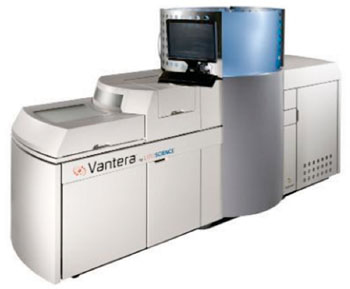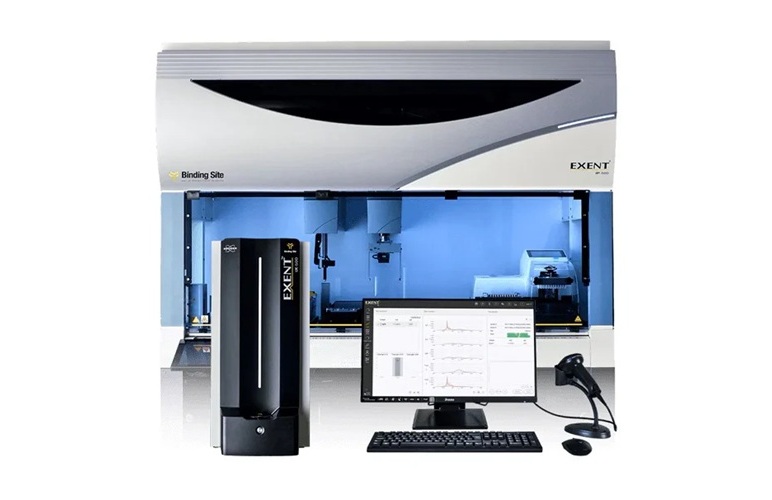LDL Particle Number Measured Using NMR Clinical Analyzer
|
By LabMedica International staff writers Posted on 25 Aug 2014 |

Image: The Vantera Clinical Analyzer offers the technology that has the ability to directly enumerate low-density lipoprotein (LDL) particle numbers (Photo courtesy of LipoScience).
Fully-automated high-throughput nuclear magnetic resonance (NMR) spectroscopy has been developed to enable measurements in a clinical laboratory setting.
NMR-measured low-density lipoprotein particle number (LDL-P) has been shown to be more strongly associated with cardiovascular disease outcomes than LDL cholesterol (LDL-C) in individuals for whom these alternate measures of LDL are discordant.
Scientists at LipoScience Inc. (Raleigh, NC, USA) purchased serum pools and controls from Solomon Park Research Laboratories (Kirkland, WA, USA). Controls were prepared by identifying serum samples with high and low lipoprotein ranges. Additional serum pools were prepared in-house from donor subjects identified at LipoScience or Mayo Clinic (Rochester, MN, USA). NMR spectra were acquired on the NMR Profiler (Bruker Bio-Spin; Billerica, MA, USA) or the Vantera Clinical Analyzer (Agilent Technologies; Santa Clara, CA, USA), both equipped with 400 MHz 1H NMR spectrometers.
The sensitivity and linearity were established within the range of 300–3,500 nmol/L. For serum pools containing low, medium and high levels of LDL-P, the inter-assay, intra-assay precision and repeatability gave coefficients of variation (CVs) between 2.6 and 5.8%. The reference interval was determined to be 457–2,282 nmol/L and the assay was compatible with multiple specimen collection tubes. Of 30 substances tested, only two exhibited the potential for assay interference. Moreover, the LDL-P results from samples run on two NMR platforms, Vantera Clinical Analyzer and NMR Profiler, showed excellent correlation.
The authors concluded that the successful development of a method to measure LDL-P on a fully automated platform allows NMR technology dissemination into the routine, clinical laboratory setting and creates the opportunity for NMR-based testing across a broader range of clinical applications. They point out that, several leading national reference laboratories and large hospital system laboratories have successfully integrated the Vantera into their clinical laboratory operations. The study was published on July 28, 2014, in the journal Clinical Biochemistry.
Related Links:
LipoScience Inc.
Mayo Clinic
Bruker Bio-Spin
NMR-measured low-density lipoprotein particle number (LDL-P) has been shown to be more strongly associated with cardiovascular disease outcomes than LDL cholesterol (LDL-C) in individuals for whom these alternate measures of LDL are discordant.
Scientists at LipoScience Inc. (Raleigh, NC, USA) purchased serum pools and controls from Solomon Park Research Laboratories (Kirkland, WA, USA). Controls were prepared by identifying serum samples with high and low lipoprotein ranges. Additional serum pools were prepared in-house from donor subjects identified at LipoScience or Mayo Clinic (Rochester, MN, USA). NMR spectra were acquired on the NMR Profiler (Bruker Bio-Spin; Billerica, MA, USA) or the Vantera Clinical Analyzer (Agilent Technologies; Santa Clara, CA, USA), both equipped with 400 MHz 1H NMR spectrometers.
The sensitivity and linearity were established within the range of 300–3,500 nmol/L. For serum pools containing low, medium and high levels of LDL-P, the inter-assay, intra-assay precision and repeatability gave coefficients of variation (CVs) between 2.6 and 5.8%. The reference interval was determined to be 457–2,282 nmol/L and the assay was compatible with multiple specimen collection tubes. Of 30 substances tested, only two exhibited the potential for assay interference. Moreover, the LDL-P results from samples run on two NMR platforms, Vantera Clinical Analyzer and NMR Profiler, showed excellent correlation.
The authors concluded that the successful development of a method to measure LDL-P on a fully automated platform allows NMR technology dissemination into the routine, clinical laboratory setting and creates the opportunity for NMR-based testing across a broader range of clinical applications. They point out that, several leading national reference laboratories and large hospital system laboratories have successfully integrated the Vantera into their clinical laboratory operations. The study was published on July 28, 2014, in the journal Clinical Biochemistry.
Related Links:
LipoScience Inc.
Mayo Clinic
Bruker Bio-Spin
Latest Clinical Chem. News
- Chemical Imaging Probe Could Track and Treat Prostate Cancer
- Mismatch Between Two Common Kidney Function Tests Indicates Serious Health Problems
- VOCs Show Promise for Early Multi-Cancer Detection
- Portable Raman Spectroscopy Offers Cost-Effective Kidney Disease Diagnosis at POC
- Gold Nanoparticles to Improve Accuracy of Ovarian Cancer Diagnosis
- Simultaneous Cell Isolation Technology Improves Cancer Diagnostic Accuracy
- Simple Non-Invasive Hair-Based Test Could Speed ALS Diagnosis
- Paper Strip Saliva Test Detects Elevated Uric Acid Levels Without Blood Draws
- Prostate Cancer Markers Based on Chemical Make-Up of Calcifications to Speed Up Detection
- Breath Test Could Help Detect Blood Cancers
- ML-Powered Gas Sensors to Detect Pathogens and AMR at POC
- Saliva-Based Cancer Detection Technology Eliminates Need for Complex Sample Preparation
- Skin Swabs Could Detect Parkinson’s Years Before Symptoms Appear
- New Clinical Chemistry Analyzer Designed to Meet Growing Demands of Modern Labs

- New Reference Measurement Procedure Standardizes Nucleic Acid Amplification Test Results
- Pen-Like Tool Quickly and Non-Invasively Detects Opioids from Skin
Channels
Molecular Diagnostics
view channel
First-Of-Its-Kind Automated System Speeds Myeloma Diagnosis
More than 176,000 people are diagnosed with multiple myeloma worldwide each year, yet the current diagnostic pathway can be slow and uncertain, often relying on a highly subjective interpretation of test results.... Read more
Blood Protein Profiles Predict Mortality Risk for Earlier Medical Intervention
Elevated levels of specific proteins in the blood can signal increased risk of mortality, according to new evidence showing that five proteins involved in cancer, inflammation, and cell regulation strongly... Read moreHematology
view channel
Platelet Activity Blood Test in Middle Age Could Identify Early Alzheimer’s Risk
Early detection of Alzheimer’s disease remains one of the biggest unmet needs in neurology, particularly because the biological changes underlying the disorder begin decades before memory symptoms appear.... Read more
Microvesicles Measurement Could Detect Vascular Injury in Sickle Cell Disease Patients
Assessing disease severity in sickle cell disease (SCD) remains challenging, especially when trying to predict hemolysis, vascular injury, and risk of complications such as vaso-occlusive crises.... Read more
ADLM’s New Coagulation Testing Guidance to Improve Care for Patients on Blood Thinners
Direct oral anticoagulants (DOACs) are one of the most common types of blood thinners. Patients take them to prevent a host of complications that could arise from blood clotting, including stroke, deep... Read moreImmunology
view channel
Gene Signature Test Predicts Response to Key Breast Cancer Treatment
DK4/6 inhibitors paired with hormone therapy have become a cornerstone treatment for advanced HR+/HER2– breast cancer, slowing tumor growth by blocking key proteins that drive cell division.... Read more
Chip Captures Cancer Cells from Blood to Help Select Right Breast Cancer Treatment
Ductal carcinoma in situ (DCIS) accounts for about a quarter of all breast cancer cases and generally carries a good prognosis. This non-invasive form of the disease may or may not become life-threatening.... Read moreMicrobiology
view channel
Rapid Assay Identifies Bloodstream Infection Pathogens Directly from Patient Samples
Bloodstream infections in sepsis progress quickly and demand rapid, precise diagnosis. Current blood-culture methods often take one to five days to identify the pathogen, leaving clinicians to treat blindly... Read more
Blood-Based Molecular Signatures to Enable Rapid EPTB Diagnosis
Extrapulmonary tuberculosis (EPTB) remains difficult to diagnose and treat because it spreads beyond the lungs and lacks easily accessible biomarkers. Despite TB infecting 10 million people yearly, the... Read more
15-Minute Blood Test Diagnoses Life-Threatening Infections in Children
Distinguishing minor childhood illnesses from potentially life-threatening infections such as sepsis or meningitis remains a major challenge in emergency care. Traditional tests can take hours, leaving... Read more
High-Throughput Enteric Panels Detect Multiple GI Bacterial Infections from Single Stool Swab Sample
Gastrointestinal (GI) infections are among the most common causes of illness worldwide, leading to over 1.7 million deaths annually and placing a heavy burden on healthcare systems. Conventional diagnostic... Read morePathology
view channel
AI Tool Outperforms Doctors in Spotting Blood Cell Abnormalities
Diagnosing blood disorders depends on recognizing subtle abnormalities in cell size, shape, and structure, yet this process is slow, subjective, and requires years of expert training. Even specialists... Read more
AI Tool Rapidly Analyzes Complex Cancer Images for Personalized Treatment
Complex digital biopsy images that typically take an expert pathologist up to 20 minutes to assess can now be analyzed in about one minute using a new artificial intelligence (AI) tool. The technology... Read moreTechnology
view channel
AI Saliva Sensor Enables Early Detection of Head and Neck Cancer
Early detection of head and neck cancer remains difficult because the disease produces few or no symptoms in its earliest stages, and lesions often lie deep within the head or neck, where biopsy or endoscopy... Read more
AI-Powered Biosensor Technology to Enable Breath Test for Lung Cancer Detection
Detecting lung cancer early remains one of the biggest challenges in oncology, largely because current tools are invasive, expensive, or unable to identify the disease in its earliest phases.... Read moreIndustry
view channel
Abbott Acquires Cancer-Screening Company Exact Sciences
Abbott (Abbott Park, IL, USA) has entered into a definitive agreement to acquire Exact Sciences (Madison, WI, USA), enabling it to enter and lead in fast-growing cancer diagnostics segments.... Read more






















